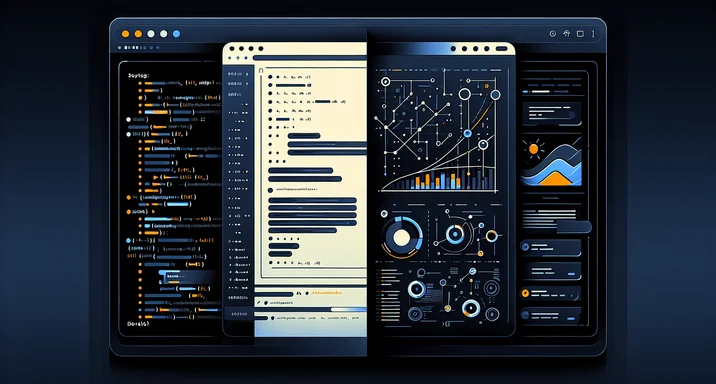
CEO & Co-founder of Visivo
Modern Analytics with BI-as-Code for Scalable Data Systems
Explore how BI-as-Code transforms analytics into scalable, automated systems that grow with your organization.

Business Intelligence has reached an inflection point. Organizations drowning in manual dashboard maintenance and struggling with inconsistent metrics are discovering a transformative approach: BI-as-Code. According to Grand View Research, "The global data analytics market will reach $684.12 billion by 2030," driving the need for scalable analytics approaches.
By managing analytics artifacts through code, teams achieve the scalability, reliability, and agility that modern data-driven businesses demand.
Understanding BI-as-Code
BI-as-Code represents a fundamental shift in how organizations create and manage analytics. Instead of clicking through graphical interfaces to build reports, analysts and engineers define dashboards, metrics, and visualizations through code. As VentureBeat reports, "87% of data science projects never make it to production," often because traditional BI approaches don't scale effectively.
This isn't just about automation—it's about applying software engineering principles to analytics development.
In traditional BI, a dashboard is a black box created through proprietary interfaces. Changes are made by individuals working in isolation, often without documentation or review. This approach contributes to Gartner's finding that "Data quality issues cost organizations an average of $12.9 million annually."
In BI-as-Code, that same dashboard becomes a transparent, version-controlled artifact:
# customer-analytics-dashboard.yml
version: "1.0.0"
name: Customer Analytics Dashboard
metrics:
- name: customer_lifetime_value
sql: |
SELECT
customer_id,
SUM(order_value) / NULLIF(DATEDIFF('month', first_order, last_order), 0) as clv
FROM customer_orders
GROUP BY customer_id
- name: churn_rate
sql: |
SELECT
COUNT(CASE WHEN last_order < CURRENT_DATE - 90 THEN 1 END) / COUNT(*) as rate
FROM customers
dashboards:
- name: customer_overview
layout:
- row:
- kpi: customer_lifetime_value
- kpi: churn_rate
- row:
- chart: customer_cohort_retention
- chart: revenue_by_segment
This code-based definition brings clarity, consistency, and control to analytics development. Every change is explicit, reviewable, and reversible, supporting developer-first BI workflows and visualizations as code practices.
Making Analytics Scalable Through Automation
BI-as-Code enables unprecedented scalability by automating repetitive tasks and enabling reuse of components. What once required manual effort for each dashboard now happens automatically through code, addressing the fact that Forrester research found that between 60% and 73% of enterprise data goes unused for analytics due to manual bottlenecks.
Component Reusability: Define metrics, calculations, and visualizations once, then reuse them across multiple dashboards:
# Reusable components library
components:
metrics:
base_revenue:
sql: "SUM(order_value)"
format: currency
active_users:
sql: "COUNT(DISTINCT user_id)"
format: number
filters:
date_range:
type: date_picker
default: last_30_days
region:
type: dropdown
source: "SELECT DISTINCT region FROM dim_geography"
# Dashboard using shared components
dashboards:
- name: regional_performance
uses:
- component: metrics.base_revenue
- component: metrics.active_users
- component: filters.date_range
- component: filters.region
Automated Generation: Create hundreds of similar dashboards programmatically:
# Generate department dashboards
departments = ["sales", "marketing", "operations", "finance"]
for dept in departments:
dashboard_config = {
"name": f"{dept}_dashboard",
"data_source": f"{dept}_data",
"metrics": standard_metrics + dept_specific_metrics[dept],
"layout": generate_layout(dept)
}
create_dashboard(dashboard_config)
Dynamic Scaling: BI-as-Code systems scale horizontally without additional complexity:
name: dashboard_example
# Scalable architecture configuration
scaling:
dashboards:
partitioning: by_region
caching: enabled
parallel_refresh: true
data_processing:
workers: auto # Scale based on load
queue: redis
max_concurrent: 100
delivery:
cdn: cloudflare
edge_locations: ["us-east", "eu-west", "ap-south"]
Integrating BI-as-Code into Data Systems
Success with BI-as-Code requires thoughtful integration into existing data infrastructure. The goal is seamless flow from data source to insight, with analytics as just another step in the data pipeline, following modern data stack alignment principles.
Version Control Integration: Store all analytics definitions in Git alongside your data transformations:
analytics-repo/
├── dbt/
│ ├── models/
│ └── tests/
├── dashboards/
│ ├── executive/
│ ├── operational/
│ └── analytical/
├── metrics/
│ └── definitions.yml
└── .github/
└── workflows/
└── deploy.yml
Automated Testing: Implement comprehensive testing for analytics artifacts, following test before dashboard deployment practices:
# analytics-tests.yml
tests:
metrics:
- name: revenue_calculation
assert:
- total_revenue > 0
- daily_revenue.sum() == total_revenue
dashboards:
- name: load_test
users: 100
duration: 300
success_criteria:
p95_response_time: < 2000ms
error_rate: < 0.01
data_quality:
- freshness:
warn: 1 hour
error: 2 hours
- completeness:
required_fields: [customer_id, order_date, amount]
Continuous Deployment: Automate the entire analytics lifecycle, implementing CI/CD analytics implementation:
name: visivo_project
# CI/CD Pipeline for Analytics
pipeline:
stages:
- validate:
- lint_yaml
- check_sql_syntax
- validate_schemas
- test:
- unit_tests
- integration_tests
- performance_tests
- deploy:
- deploy_to_staging
- smoke_tests
- deploy_to_production
- monitor_deployment
Achieving Next-Generation BI Workflows
BI-as-Code enables workflows that were impossible with traditional BI tools. Teams work faster, make fewer errors, and deliver more value to the business.
Parallel Development: Multiple team members work on different features simultaneously without conflicts:
# Developer 1: Working on sales dashboards
git checkout -b feature/sales-dashboard
# Makes changes to sales dashboards
git commit -m "Add quarterly sales trends"
# Developer 2: Working on marketing dashboards
git checkout -b feature/marketing-dashboard
# Makes changes to marketing dashboards
git commit -m "Add campaign performance metrics"
# Both changes merge without conflicts
git merge feature/sales-dashboard
git merge feature/marketing-dashboard
Instant Rollbacks: When issues occur, recovery is immediate:
# Problem detected in production
alert: "Revenue calculation showing anomaly"
# Immediate rollback
visivo rollback --environment production --version previous
# Time to recovery: < 1 minute
Self-Service Analytics: Business users can request changes through pull requests, using track changes with pull requests workflows:
# Business user submits PR for new metric
# new-metric-request.yml
metrics:
- name: customer_satisfaction_score
description: "Average CSAT score by region"
requested_by: "jane.doe@company.com"
sql: |
SELECT
region,
AVG(satisfaction_score) as csat
FROM customer_surveys
WHERE survey_date >= CURRENT_DATE - 30
GROUP BY region
Analytics Observability: Monitor your entire analytics stack:
observability:
metrics:
- dashboard_load_time
- query_execution_time
- user_engagement_rate
- data_freshness
alerts:
- metric: dashboard_error_rate
threshold: > 0.01
action: page_on_call
- metric: data_staleness
threshold: > 2 hours
action: notify_data_team
The transformation is profound. Organizations implementing BI-as-Code report:
- Significant reduction in dashboard development time
- Fewer production incidents
- Faster onboarding of new team members
- Improvement in metric consistency
These improvements support MIT's research showing "Companies using data-driven strategies have 5-6% higher productivity" when their analytics infrastructure scales systematically.
BI-as-Code isn't just a technical improvement—it's a competitive advantage. As data volumes grow and analytics becomes more critical to business success, the ability to scale analytics programmatically becomes essential. Organizations that embrace BI-as-Code today are building the analytics infrastructure that will power their growth tomorrow.
For related topics, explore our guides on YAML vs GUI BI configuration, dashboard version control collaboration, and faster feedback cycles.

